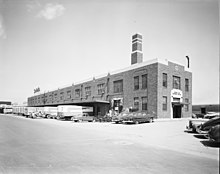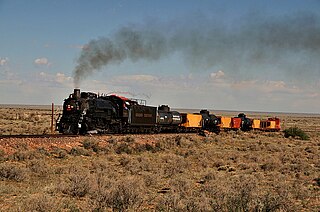
The Grand Canyon Railway is a heritage railroad which carries passengers between Williams, Arizona, and the South Rim of Grand Canyon National Park.

El Paso Union Depot is an Amtrak train station in El Paso, Texas, served by the Texas Eagle and Sunset Limited. The station was designed by architect Daniel Burnham, who also designed Washington Union Station in Washington, D.C., which was built between 1905 and 1906 and was added to the National Register of Historic Places in 1971.

Santa Fe Depot, also known as the Santa Fe Transit Hub, is an Amtrak station located in downtown Oklahoma City, Oklahoma. It is the northern terminus of the Heartland Flyer, a daily train to Fort Worth, Texas.

Norman is an Amtrak station in Norman, Oklahoma. The station is serviced by the daily Heartland Flyer, which travels from Fort Worth, Texas to Oklahoma City, Oklahoma. The station building was added to the National Register of Historic Places in 1991 as the Santa Fe Depot.

Santa Fe Depot is a union station in San Diego, California, built by the Atchison, Topeka and Santa Fe Railway to replace the small Victorian-style structure erected in 1887 for the California Southern Railroad Company. The Spanish Colonial Revival style station is listed on the National Register of Historic Places and is a San Diego Historic Landmark. Its architecture, particularly the signature twin domes, is often echoed in the design of modern buildings in downtown San Diego.

The Gulf, Colorado and Santa Fe Railway (GC&SF) was chartered in Texas in 1873 to build a railroad from Galveston, Texas, to Santa Fe, New Mexico. By 1886, it had built from Galveston to a junction in Temple, Texas, which was founded by the company. From Temple, one line went north to Dallas and Fort Worth via a junction in Cleburne, while a second line extended northwest and terminated near Coleman, Texas.

Ardmore is an Amtrak train station in Ardmore, Oklahoma. The station is serviced by the daily Heartland Flyer, which travels from Oklahoma City, Oklahoma to Fort Worth, Texas.
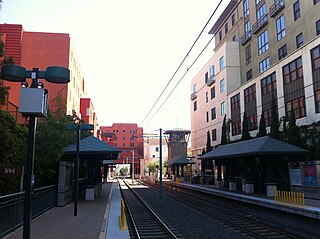
Del Mar station is an at-grade light rail station on the A Line of the Los Angeles Metro Rail system. It is located between Arroyo Seco Parkway and Raymond Avenue at Del Mar Boulevard, after which the station is named, in Pasadena, California. The station is located on the site of the historic Pasadena Santa Fe Depot and the station building, built in 1935, still stands on the property.
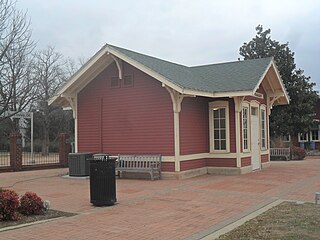
Pauls Valley is an Amtrak station in Pauls Valley, Oklahoma. The station is serviced by the daily Heartland Flyer, which travels from Oklahoma City, Oklahoma to Fort Worth, Texas.

Purcell is an Amtrak station in Purcell, Oklahoma. The station is serviced by Amtrak's daily Heartland Flyer, which travels from Oklahoma City, Oklahoma to Fort Worth, Texas.

The Atchison, Topeka and Santa Fe Passenger and Freight Complex is a nationally recognized historic district located in Fort Madison, Iowa, United States. It was listed on the National Register of Historic Places in 1992. At the time of its nomination it contained three resources, all of which are contributing buildings. The buildings were constructed over a 24-year time period, and reflect the styles that were popular when they were built. The facility currently houses a local history museum, and after renovations a portion of it was converted back to a passenger train depot for Amtrak, which opened on December 15, 2021.

The Chicagoan and Kansas Cityan were a pair of American named passenger trains operated by the Atchison, Topeka and Santa Fe Railway. They ran between Chicago, Illinois and Oklahoma City, Oklahoma. The trains were introduced as a Chicago–Wichita service in 1938 and extended to Oklahoma City the next year. A Kansas City–Tulsa connecting train, the Tulsan, was also introduced at that time. The Chicagoan and Kansas Cityan ran until 1968, while the Tulsan ran until 1971.

Santa Fe Depot is the northern terminus of the New Mexico Rail Runner Express commuter rail line. The station was originally built by the Atchison, Topeka and Santa Fe, and until 2014 served as the northern terminus, offices, and gift shop of the Santa Fe Southern Railway, a tourist and freight carrying short line railroad. It is located in Santa Fe, New Mexico at 410 Guadalupe Street, within an area of urban renewal referred to as the "Railyard". Rail Runner service to the station began on December 17, 2008.

The Southern Transcon is a main line of the BNSF Railway comprising 11 subdivisions between Southern California and Chicago, Illinois. Completed in its current alignment in 1908 by the Atchison, Topeka and Santa Fe Railway, when it opened the Belen Cutoff in New Mexico and bypassed the steep grades of Raton Pass, it now serves as a mostly double-tracked intermodal corridor.

Guthrie station is a former railway station in Guthrie, Oklahoma. Built in 1903, it saw passenger service until 1979 and is now a restaurant. The building is a contributing resource of the Guthrie Historic District.

The Fort Worth and Rio Grande Railway, chartered under the laws of Texas on June 1, 1885, was part of a plan conceived by Buckley Burton Paddock and other Fort Worth civic leaders to create a transcontinental route linking New York, Fort Worth, and the Pacific port of Topolobampo, which they believed would stimulate the growth and development of southwest Texas in general, and the economy of Fort Worth in particular.

Gulf, Colorado and Santa Fe Railroad Passenger Station is a former passenger train station in Fort Worth, Texas. From 1971 to 2002, it was used as Fort Worth's Amtrak station.
Edward Alfred Harrison, known as E. A. Harrison, was an American architect who worked as a staff architect for the Atchison, Topeka & Santa Fe Railway, with offices in Topeka, Kansas, and later in Chicago, Illinois.
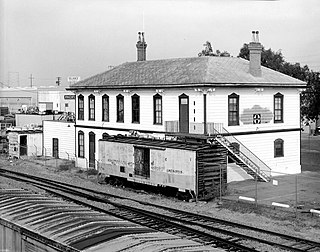
National City station is a former railway station in National City, California. The California Southern Railroad, a subsidiary of the Atchison, Topeka and Santa Fe Railway, chose National City as the West Coast base of operations at the terminus of their planned transcontinental railroad.

Atchison, Topeka and Santa Fe Passenger Depot or Santa Fe Station in Colorado Springs, Colorado, is a historic railway station. The grand depot and Harvey House was built in 1917 as a joint Santa Fe/Colorado and Southern Railway facility. In 1972, the Santa Fe tracks through Colorado Springs were removed and rail operations were consolidated on the former Rio Grande trackage on the west side of town. The depot and the nearby express building now serves as Catalyst Campus for Technology and Innovation.

